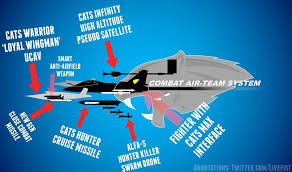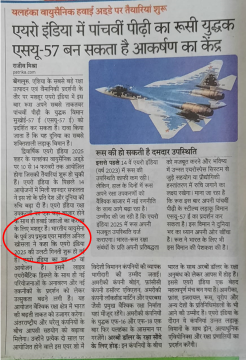
Pic Courtesy Net
My Article published on the EurasiaTimes website on 11 Dec 24.
The “Loyal Wingman” concept refers to an innovative approach in military aviation where autonomous or semi-autonomous drones or unmanned combat aerial vehicles (UCAVs) work in tandem with piloted aircraft to perform various support and combat missions. These drones act as “wingmen” to human pilots, providing increased situational awareness, expanding mission capabilities, and reducing the risk to human pilots by taking on more dangerous or complex tasks.
Roles, Tasks and Missions. Loyal wingmen can perform numerous roles, tasks and missions. They can conduct ISR (Intelligence, Surveillance, and Reconnaissance) missions, gathering real-time data and electronic jamming to disrupt enemy communications, radar, or defence systems. They can carry out precision strikes against enemy targets or act as decoys to draw enemy fire, helping protect manned aircraft. They can also provide additional defensive cover to the manned flights, using onboard sensors to detect incoming threats such as missiles or hostile aircraft.
Advantages. The Loyal Wingman concept offers numerous advantages across various aspects of military operations. Multiple drones working in tandem with a manned platform allow one pilot to manage more assets, effectively increasing the overall combat power without needing additional manned aircraft. They allow a more aggressive approach without fear of losing expensive manned aircraft or risking human lives. Loyal wingmen are often equipped with advanced sensors and communication systems, allowing them to gather and share real-time intelligence with the manned aircraft. This increases the pilot’s situational awareness by providing additional eyes on the battlefield, detecting threats, and providing early warning of incoming dangers. Their modular design allows for rapid reconfiguration based on mission requirements and is more cost-effective.
Technology Enablers. The Loyal Wingman concept relies on various advanced technologies to enable autonomous drones to work alongside manned aircraft in combat operations. These technologies ensure that drones can perform tasks efficiently. AI enables Loyal Wingman drones to operate independently or semi-autonomously, making real-time decisions without constant human input. AI also allows for coordination between multiple drones and manned aircraft. Loyal Wingman drones have advanced sensors that gather data across multiple spectrums, as well as secure communications and data links. Advanced navigation systems allow them to operate in environments where GPS signals may be jammed or unavailable. Many Loyal Wingman drones are designed with low radar cross-sections (RCS), infrared suppression, and other stealth features to reduce their visibility to enemy radar and sensors. An intuitive Human-Machine interface, including voice commands, graphical interfaces, or augmented reality (AR) systems, is crucial for operational success.
Loyal Wingman Projects Under Development
Several nations and defence organisations worldwide are actively developing the Loyal Wingman concept.
Boeing Airpower Teaming System (ATS). The Boeing Airpower Teaming System (ATS) is a ground breaking unmanned combat aircraft developed by Boeing in collaboration with the Royal Australian Air Force (RAAF). It is designed with advanced artificial intelligence (AI) and autonomy. This allows the ATS to coordinate with manned aircraft such as the F/A-18 Super Hornet, F-35 Lightning II, or other fighter jets. The ATS can operate independently or under minimal human supervision, making real-time decisions based on mission objectives, threats, and the battlefield environment. One of the ATS’s most innovative aspects is its modular payload design. The ATS is designed to minimise its radar signature, making it more difficult for enemy forces to detect and engage. Its high speed enables it to keep up with manned fighter jets and effectively perform coordinated operations. The ATS conducted its first successful flight in March 2021, marking a significant milestone in developing unmanned teaming technology.
Skyborg. Skyborg is an ambitious program developed by the United States Air Force (USAF) to create a family of autonomous, unmanned combat aerial vehicles (UCAVs) that can operate alongside manned aircraft, functioning as “loyal wingmen” and performing a wide range of missions. The Skyborg initiative is part of the broader USAF vision of developing low-cost, expendable unmanned systems to complement manned aircraft like the F-35 Lightning II, F-22 Raptor, and other next-generation platforms. The core of the Skyborg program is the development of a robust autonomy core system (ACS)—a sophisticated AI platform that allows UAVs to fly and fight with little to no human input. The Skyborg program involves partnerships with several aerospace and defence companies, including Boeing, Kratos Defense, General Atomics, and Northrop Grumman, developing different UAV platforms to test Skyborg’s AI capabilities. These companies provide the hardware and airframes, while the USAF focuses on integrating the AI systems. One of the most notable platforms associated with Skyborg is the Kratos XQ-58A Valkyrie, an unmanned aerial vehicle considered a key candidate for Skyborg operations. Other platforms, like the General Atomics MQ-20 Avenger and Boeing ATS (Airpower Teaming System), are also being tested for Skyborg’s AI-driven operations. The first successful flight of a Skyborg-equipped drone took place in April 2021, when the autonomy core system was tested on a Kratos Valkyrie UAV. This marked a significant milestone in demonstrating the AI’s ability to operate autonomously, navigate, and perform essential mission functions without human intervention. The Skyborg program represents a crucial shift in the USAF’s approach to air combat, emphasising the importance of autonomous systems in future warfare.
Kratos XQ-58A Valkyrie. The Kratos XQ-58A Valkyrie is an experimental unmanned combat aerial vehicle (UCAV) developed by Kratos Defense & Security Solutions for the United States Air Force (USAF) as part of its Low-Cost Attritable Aircraft Technology (LCAAT) initiative. The XQ-58A is designed to function as a “loyal wingman,” supporting manned aircraft by performing various missions autonomously or under human supervision. It aims to offer a low-cost, expendable option for future combat scenarios. The XQ-58A Valkyrie is designed to operate in various roles alongside manned aircraft, such as the F-35 or F-22. The Valkyrie flew in March 2019 at Yuma Proving Ground in Arizona. Since then, it has undergone several test flights, demonstrating its ability to fly autonomously, deploy weapons, and work in tandem with manned aircraft. The ongoing development is focused on further integrating the aircraft into USAF operations and exploring its full range of mission capabilities. The project aligns with the Skyborg program.
Future Combat Air System (FCAS) Loyal Wing Man Project of Europe. The Future Combat Air System (FCAS) is a major European defence initiative to develop a next-generation air combat capability. It involves several countries, primarily France, Germany, and Spain. It focuses on integrating advanced technologies into a new family of systems that will replace the ageing fleets of fighter aircraft, such as the Eurofighter Typhoon and Dassault Rafale. A vital aspect of the FCAS is the development of loyal wingman drones designed to work alongside manned fighter jets. The FCAS project was officially launched in 2017. The program envisions a network of systems, often called the “system of systems,” that can communicate and operate together in a complex battlefield environment. The FCAS program is structured in phases. The goal is to have a prototype of the next-generation fighter by the mid-2030s. According to recent updates, the FCAS program continues to evolve, with ongoing discussions about integrating technologies and the roles of various nations in the project.
Loyal Wing Man Project Flygplan 2020 of Sweden. The Loyal Wingman Project in Sweden, known as Flygplan 2020 (or Airplane 2020), is an initiative to develop an advanced unmanned aerial vehicle (UAV) that will operate alongside Sweden’s manned fighter jets, mainly the Saab JAS 39 Gripen. The Flygplan 2020 project is being developed with various partners, including defence industry stakeholders, research institutions, and the Swedish Armed Forces. Saab, a leading aerospace and defence company, plays a crucial role in the project, leveraging its aircraft design and development expertise. The Flygplan 2020 project incorporates cutting-edge technologies, including advanced avionics, communications systems, and data fusion capabilities. While specific timelines for the Flygplan 2020 project may vary, the development of loyal wingman capabilities is expected to progress in line with advancements in drone technology and changing defence needs.
Russia’s Loyal Wing Man. Like other nations, Russia is also pursuing the development of the Loyal Wingman system. The Okhotnik-B is a stealthy unmanned combat aerial vehicle (UCAV) developed by Sukhoi. It is designed for various roles, including reconnaissance and precision strikes. The Okhotnik-B features a flying wing design for reduced radar signature and is intended to operate in conjunction with manned aircraft, such as the Su-57 fighter jet. The Orion drone is designed for reconnaissance and strike missions. While not a traditional Loyal Wingman platform, its capabilities align with the concept by enabling it to operate alongside manned fighters and support them in various roles. Russian Loyal Wingman systems prioritise stealth capabilities, with designs that minimise radar cross-section and infrared signatures. Russia also aims to develop UCAVs that can operate autonomously or semi-autonomously. While Russia has made strides in developing Loyal Wingman systems, it faces challenges in achieving the same technological sophistication as in some other systems.
China’s Loyal Wingman. China has significantly advanced in developing its own Loyal Wingman systems. The CH-7 is an unmanned combat aerial vehicle (UCAV) developed by the Aviation Industry Corporation of China (AVIC). The CH-7 features stealthy design elements, advanced avionics, and a modular payload system, making it capable of operating alongside manned aircraft in combat scenarios. While primarily recognised as a reconnaissance and strike drone, the Wing Loong series (e.g., Wing Loong II) showcases capabilities that align with the Loyal Wingman concept. Another notable UCAV, the GJ-11, is designed with stealth features and advanced avionics. These drones are designed to coordinate with manned platforms. Chinese Loyal Wingman systems, like Russian systems, are designed to focus on low observability. China is heavily investing in AI technologies to enhance the autonomy of its Loyal Wingman systems. These drones are expected to operate semi-autonomously or autonomously, making real-time decisions during missions and adapting to changing battlefield conditions. China actively seeks to export its UAV technologies. China’s Loyal Wingman systems are expected to play a significant role in its military strategy and regional power projection.
Indian HAL’s CATS.

HAL CATS (Combat Air Teaming System) is an advanced unmanned combat aerial vehicle (UCAV) program being developed by Hindustan Aeronautics Limited (HAL) in collaboration with other Indian defence agencies. The program is part of India’s effort to develop indigenous drone technologies capable of operating alongside manned aircraft. HAL CATS aligns with the growing global trend of integrating unmanned systems with traditional fighter jets through Manned-Unmanned Teaming (MUM-T). The CATS program includes multiple drone systems and components that work synergistically with manned aircraft, particularly with India’s HAL Tejas Light Combat Aircraft (LCA) and other future platforms. CATS’ key elements include the following:-
-
- CATS Warrior. The CATS Warrior is a loyal wingman UAV designed to fly alongside manned fighter jets, like the HAL Tejas. It can operate autonomously or under the direction of the manned aircraft, performing tasks such as reconnaissance, surveillance, and strike missions. The CATS Warrior will be armed with precision-guided munitions and can take on enemy targets independently or in support of manned aircraft. Its design focuses on being stealthy, agile, and capable of engaging in high-risk environments where manned platforms might face significant threats.
-
- CATS Hunter. CATS Hunter is a high-speed drone designed to act as a cruise missile capable of long-range precision strikes. It can be deployed from manned aircraft or larger UAVs and is intended for missions that require attacking heavily defended or high-value targets. It will carry advanced payloads such as precision-guided bombs and can strike enemy radar installations, command centers, and other critical infrastructure.
-
- CATS Alpha. CATS Alpha is a smaller, swarming drone working in groups to overwhelm enemy defences. These drones can be deployed in large numbers from manned or unmanned platforms to perform a variety of missions, including reconnaissance, electronic warfare, and decoy operations. The idea is for CATS Alpha to create confusion and disrupt enemy systems, allowing manned and larger unmanned platforms to penetrate deeper into contested areas.
-
- CATS Infinity. CATS Infinity is a long-range, high-altitude drone designed for intelligence, surveillance, and reconnaissance (ISR) missions. It will operate at high altitudes for extended periods, providing continuous data to ground commanders and manned aircraft. CATS Infinity will likely monitor large areas, gather intelligence on enemy movements, and support strike planning by providing real-time data.
The HAL CATS program represents a significant step for India in developing indigenous unmanned combat systems. With increasing threats from neighbouring adversaries and a push to modernise India’s air force, CATS is crucial in bolstering the country’s aerial defence and combat capabilities. As autonomous systems become more sophisticated, HAL CATS could form the backbone of India’s future air warfare strategy. Complementing manned platforms like the Tejas and future fighters would provide a flexible, powerful, and resilient air force capable of handling modern combat challenges.
Your valuable comments are most welcome.
Link to the published article:
https://www.eurasiantimes.com/bodyguards-of-future-fighter-jets/
For regular updates, please register your email here:-
References and credits
To all the online sites and channels.
References:
-
- Bradley Perrett “Design of Boeing’s loyal wingman gives clues about performance and roles”, Australian Strategic Policy Institute, 18 Nov 2021.
-
- Greg Hadley, “Wildly Successful’ Skyborg Will Become Program of Record but Won’t Stop Developing S&T”, Air & Space Forces Magazine, 16 Aug 2022.
-
- “Europe’s Competing Future Combat Air Systems”, EDR Magazine, 59 September-October 2021.
-
- Thomas Newdick, “This Is Saab’s Concept For A Supersonic, Stealthy Loyal Wingman Drone”, The War Zone, 09 Feb 2024.
-
- Thomas Newdick, “Russia’s Aspirational Grom Combat Drone’s Design Totally Changes, Ditches Stealth For Speed”, The War Zone, 13 Aug 2024.
-
- Seong Hyeon Choi, “China’s GJ-11 stealth drone sightings hint at future role as fighter jet ‘wingmen’”, SCMP, 15 Sep 2024.
-
- Prasad Gore, “Decoding HAL CATS Program” Defence XP, 06 Feb 2021.
-
- Insinna Valerie, “Emerging Technology in the Air Force: The Skyborg and Loyal Wingman Programs.” Defense News, 2023.
-
- “Boeing Loyal Wingman Uncrewed Aircraft Completes First Flight.” Boeing Media Release, March 2, 2021.
-
- Dr Jean-Marc Rickli, Head, Global and Emerging Security Risk, Geneva Centre for Security Policy, Switzerland, “Human-Machine Teaming in Artificial Intelligence-Driven Air Power: Future Challenges and Opportunities for the Air Force”. The Air Power Journal, Second Edition (2022).
-
- Jing Lei, Jia-Qing Song, Yan-Yan Zhu, “Analysis of the “Loyal Wingman” Technology of UAV Cooperative Operation”, International Journal of Research in Engineering and Science (IJRES), Volume 12 Issue 3 ǁ March 2024.
Disclaimer:
Information and data included in the blog are for educational & non-commercial purposes only and have been carefully adapted, excerpted, or edited from reliable and accurate sources. All copyrighted material belongs to respective owners and is provided only for wider dissemination.




